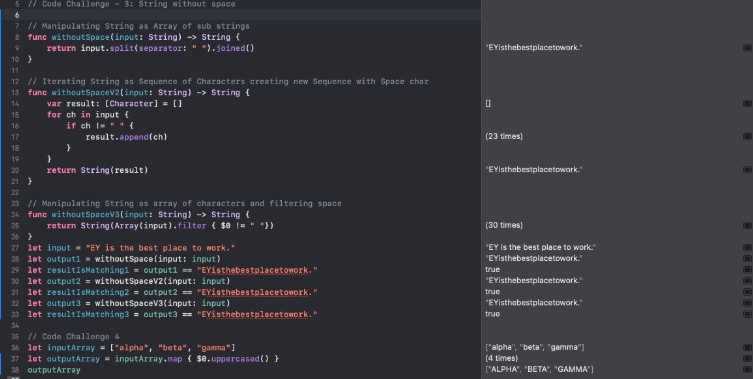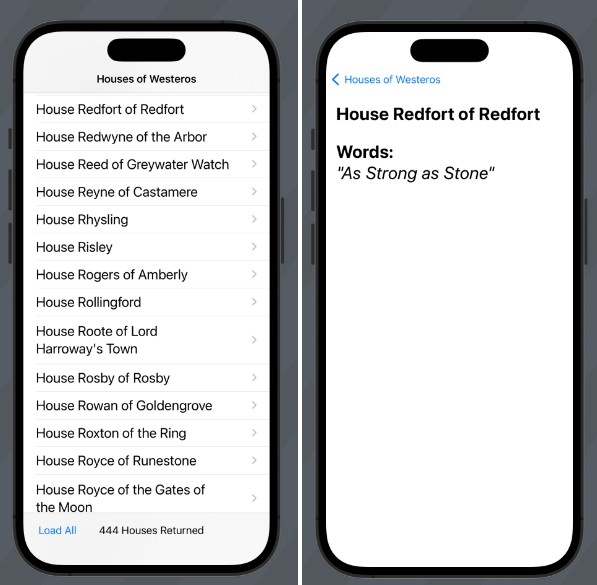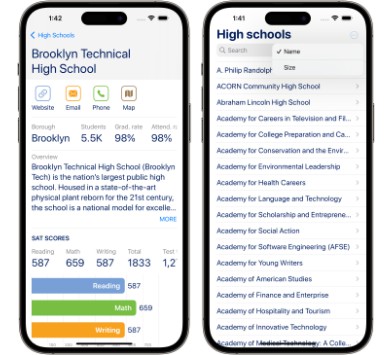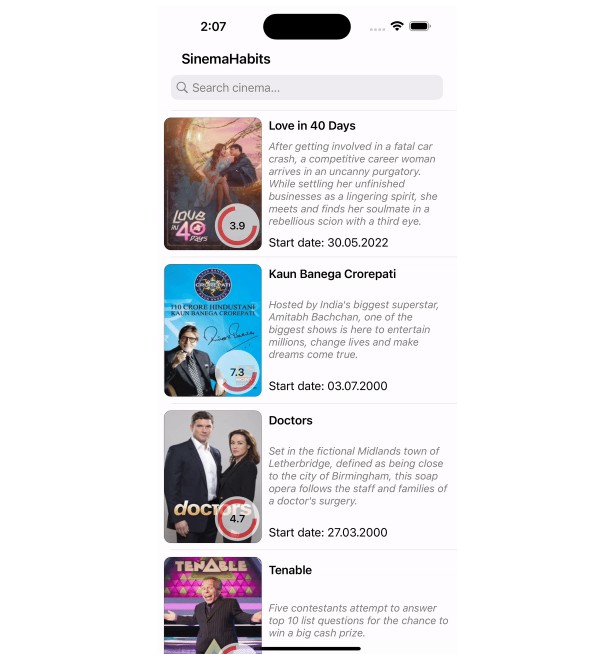Swift / iOS Code Challenge
This repository contains some code example of latest iOS and Swift.
System Requirements
-
macOS Monterey (v12.4)
-
XCode v13.4.1
-
Swift 5.5
How to run
This code examples are tested on iOS 15.1 iPod 7 Generation simulator.
-
Open
CodeChallenge.xcworkspacein Xcode -
Build Application (CMD + B)
-
Select target simulator and run application (CMD + R)
Code Challenges
Most of the code examples are implemented as part of Single View UIKit based iOS application.
The initial view controller (ViewController.swift) is used as index page to invoke different code examples
Index View / Screen (ViewController.swift)
The following button items are presenting and invoking different challenge results
-
API call with Closure– Challenge – 1 -
API call with Async– Challenge – 1 -
UIKit Color Selector– Challenge – 2 -
SwiftUI Color Selector– Challenge – 2 -
UIKit IB Logo– Challenge – 5 -
UIKit Logo– Challenge – 5 -
SwiftUI Logo– Challenge – 5 -
Logo View Segue– Challenge – 6 -
Swift UI Logo VC– Challenge – 6 -
Swift UI Logo Modal– Challenge – 6
Challenge 1
Your client has a need to asynchronously communicate with a third-party service. This serice is at url http://ip.jsontest.com/. The request is a GET. The request requires no payload. The response will be similar to the following json {"ip": "11.11.11.11"}. Make a call to this service without blocking the application and display the results in the application log.
Create an asynchronous request to request data from the endpoint. Ensure you do not block the user interface. Print result to log. Update user interface label with result. Include appropriate error handling.
Please provide two different approaches.
- Async / await pattern
- Closure callback pattern
The code example is implemented in Challenge-1/ApiCall.swift and invoked
in ViewController.swift by clicking
API call with Closure(Closure based)
@IBAction func apiAction(_ sender: Any) {
self.ipClosureActionButton?.alpha = 0.3;
self.ipClosureActionActivity?.isHidden = false;
self.apiCaller.getIP { result in
DispatchQueue.main.async {
self.ipClosureActionButton?.alpha = 1.0;
self.ipClosureActionActivity?.isHidden = true;
}
switch result {
case .success(let ip):
print("Closure IP: \(ip)")
DispatchQueue.main.async {
self.ipLabel?.text = "IP Address (closure): \(ip)"
}
case .failure(let err):
print("Closure API error: \(err)")
DispatchQueue.main.async {
self.ipLabel?.text = "IP detection fail with error (closure): \(err)"
}
}
}
}
API call with Async(Async / await pattern)
@IBAction func apiActionWithAsync(_ sender: Any) {
self.asyncClosureActionButton?.alpha = 0.3
self.asyncClosureActionActivity?.isHidden = false;
do {
Task.init {
do {
let result = try await self.apiCaller.getIp();
DispatchQueue.main.async {
self.asyncClosureActionButton?.alpha = 1.0
self.asyncClosureActionActivity?.isHidden = true;
}
switch result {
case .success(let ip):
print("Async IP: \(ip)")
DispatchQueue.main.async {
self.ipLabel?.text = "IP Address (async): \(ip)"
}
case .failure(let err):
print("Async error: \(err)")
DispatchQueue.main.async {
self.ipLabel?.text = "IP detection fail with error (async): \(err)"
}
}
} catch let error {
print("Api call fail with error \(error)")
DispatchQueue.main.async {
self.ipLabel?.text = "IP detection fail with error (async): \(error)"
}
}
}
}
}
Challenge 2
Create a segmented controller with six color options. As the different segments are selected, change the color of the segment to the color selected. Make sure to update the user interface color in the correct thread.
Please provide two different approaches.
- UIKit
The UIKit version of the solution is implemented in ColorSelectionViewController.swift using storyboard and invoked through
ViewController.swift by the button click UIKit Color Selection
@IBAction func showUIKitColorSelector(_ sender: Any) {}
- SwiftUI
SwiftUI version of code example is implemented in ColorSelectSwiftUIView.swift and user can view this screen through ViewController.swift / SwiftUI Color Select button
@IBAction func showSwiftUIColorSelectView(_ sender: Any) {}
Challenge 3
Create a method that will take in string and return the same string without any spaces. For example “EY is the best place to work.” would be returned as “EYisthebestplacetowork.” Do this without the use of string methods like replacingOccurrences. We want to see you manipulate the string directly.
The code example is implemented in Challenge-3-4-7/CodeChallengePlayground.playground
// Code Challenge - 3: String without space
// Manipulating String as Array of sub strings
func withoutSpace(input: String) -> String {
return input.split(separator: " ").joined()
}
// Iterating String as Sequence of Characters creating new Sequence with Space char
func withoutSpaceV2(input: String) -> String {
var result: [Character] = []
for ch in input {
if ch != " " {
result.append(ch)
}
}
return String(result)
}
// Manipulating String as array of characters and filtering space
func withoutSpaceV3(input: String) -> String {
return String(Array(input).filter { $0 != " "})
}
let input = "EY is the best place to work."
let output1 = withoutSpace(input: input)
let resultIsMatching1 = output1 == "EYisthebestplacetowork."
let output2 = withoutSpaceV2(input: input)
let resultIsMatching2 = output2 == "EYisthebestplacetowork."
let output3 = withoutSpaceV3(input: input)
let resultIsMatching3 = output3 == "EYisthebestplacetowork."
Challenge 4
Use the best pattern to return the following array string as an array of uppercase strings. [“alpha”, “beta”, “gamma”] There is a way to accomplish this with one line of code.
The code example is implemented in Challenge-3-4-7/CodeChallengePlayground.playground
// Code Challenge 4
let inputArray = ["alpha", "beta", "gamma"]
let outputArray = inputArray.map { $0.uppercased() }
Challenge 5
Create a view controller segue that shows a new view controller with the EY logo centered regardless of the size device used. Make sure you have a back button to return to the original view controller.
Please provide three different approaches.
- Interface Builder
- UIKit
- SwiftUI
All three solution is implemented in Group Challenge-5-6
Interface Builder Example
The example is implemented by LogoIBViewController.swift, interface is developed in Main.storyboard. View is presented with UIKit IB Logo button action of ViewController.swift
UIKit
This UIKit version of the solution is implemented by programmatically view creation in LogoUIKViewController.swift
func createImageView() {
let image: UIImage = #imageLiteral(resourceName: "ey")
let imageView = UIImageView(image: image)
imageView.frame = CGRect(x: 0, y: 0, width: 2, height: 120)
imageView.contentMode = .scaleAspectFit
imageView.tag = imageViewTag
imageView.translatesAutoresizingMaskIntoConstraints = false
self.view.addSubview(imageView)
let xConstraint = NSLayoutConstraint(item: imageView, attribute: .centerX, relatedBy: .equal, toItem: self.view, attribute: .centerX, multiplier: 1.0, constant: 0);
let yConstraint = NSLayoutConstraint(item: imageView, attribute: .centerY, relatedBy: .equal, toItem: self.view, attribute: .centerY, multiplier: 1.0, constant: 0)
let widthConstraint = NSLayoutConstraint(item: imageView, attribute: .width, relatedBy: .equal, toItem: nil, attribute: .notAnAttribute, multiplier: 1.0, constant: 120)
let heightConstraint = NSLayoutConstraint(item: imageView, attribute: .height, relatedBy: .equal, toItem: nil, attribute: .notAnAttribute, multiplier: 1.0, constant: 120)
self.view.addConstraint(xConstraint)
self.view.addConstraint(yConstraint)
imageView.addConstraint(widthConstraint)
imageView.addConstraint(heightConstraint)
self.view?.layoutSubviews()
}
SwiftUI
The SwiftUI version is implemented in LogoSwiftView.swift and view is presented from SwiftUI Logo button action of ViewController.swift
struct ContentView: View {
var body: some View {
Image("ey")
.resizable()
.aspectRatio(contentMode: .fill)
.frame(width: 120, height: 120, alignment: .center)
.border(Color.blue, width: 3.0)
.clipped()
}
}
Challenge 6
Use code only (no Interface Builder or xib) to create a view controller segue that shows a new view controller with the EY logo centered regardless of the size device used. Make sure you have a back button to return to the original view controller.
Please provide two different approaches.
- UIKit
- SwiftUI
Assumption and decisions
-
Segue is view presentation technique for Storyboard. Here, we implemented a programmatic invocation of storyboard segue.
-
LogoUIKViewController.swiftview rendering/layout segment is developed programmatically without Interface builder or StoryBoard, hence that is presented. -
LogoSwiftUIViewController.swift(a programmatic subclass ofUIHostingController) is presenting storyboardHostingview-controller object. Here, we invoke segue programmatically. -
For
SwiftUIview, we created a programmatic modal presentation withLogoSwiftViewModal.swiftwith dismiss action (No Interface builder or Storyboard).
UIKit Version
In the ViewController.swift on touch up of Logo View Segue action, the previously created LogoUIKViewController.swift controller is presented programmatically.
// Code Challenge 6
@IBAction func showLogoViewProgrammatically(_ sender: Any) {
self.performSegue(withIdentifier: "showLogoView", sender: self)
}
SwiftUI Version
In the ViewController.swift on touch up of SwiftUI Logo VC action is presenting LogoSwiftUIViewController.swift view by programmatically invoking segue in Main.storyboard
@IBAction func showLogoSwiftVC(_ sender: Any) {
self.performSegue(withIdentifier: "showSwiftUILogoVC", sender: self)
}
and SwiftUI Logo Modal is presenting LogoSwiftViewModal.swift in modal transition.
@IBAction func showLogoSwiftVCInModal(_ sender: Any) {
self.present(UIHostingController(rootView: LogoSwiftViewModal(container: self)), animated: true)
}
Challenge 7
Demonstrate your understanding of Combine’s Publisher and Subscriber by creating a simple publisher that you can subscribe to. After subscribing, demonstrate that you receive and respond to events (write to debug log) and that you can cancel the subscription if desired.
The code example is implemented in Challenge-3-4-7/CodeChallengePlayground.playground
// Code Challenge 7
// Event type
typealias Event = String
// Event param tuple
typealias EventData = (event: Event, info: Any?)
// Event callba
ck closure type
typealias EventHandler = (_ event: EventData) -> Void
// Class ref to store event handler
class ListenerRef {
var eventHandlerRef: EventHandler?
init(handler: @escaping EventHandler) {
self.eventHandlerRef = handler
}
func unSubscribe() {
print("unsubscribing")
self.eventHandlerRef = nil
}
}
// Publisher
struct Publisher {
var listeners: [Event : [ListenerRef]] = [:]
mutating func subscribe(event: Event,_ handler: @escaping EventHandler) -> ListenerRef {
var eventListeners: [ListenerRef] = self.listeners[event] ?? []
let listenerRef = ListenerRef(handler: handler)
eventListeners.append(listenerRef)
self.listeners[event] = eventListeners
return listenerRef
}
func publish(event: Event, info: Any?) {
// Get listener
let eventListeners: [ListenerRef] = self.listeners[event] ?? []
for listener in eventListeners {
if let handler: EventHandler = listener.eventHandlerRef {
handler((event, info))
} else {
print("subscription removed")
}
}
}
}
// Global publisher obj
var globalPublisher = Publisher()
// Subscription to "hello" event
var subscription = globalPublisher.subscribe(event: "hello") { event in
let eventString = event.event
print("HelloEventHandler: Received event: \(eventString) | info: \(event.info ?? "No Info")")
}
// Publishing "hello" event without data
globalPublisher.publish(event: "hello", info: nil)
// Publishing "hello" event with data
globalPublisher.publish(event: "hello", info: "world")
// Subscription to "test" event
var subscription2 = globalPublisher.subscribe(event: "test") { event in
let eventString = event.event
print("TestEventHandler: Received event: \(eventString) | info: \(event.info ?? "No Info")")
}
// Publishing test event
globalPublisher.publish(event: "test", info: "my event")
// Unsubscribing: "hello event"
subscription.unSubscribe()
globalPublisher.publish(event: "hello", info: nil)
globalPublisher.publish(event: "test", info: "my event - New")
Known issues and conclusion
-
Application is not tested in iOS device.
-
No Unit or UI tests are added
-
Due to lack of time some variable names are not perfect.












